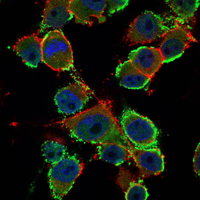CD66e Monoclonal Antibody
- Catalog No.:YM0129
- Applications:WB;IF;ELISA
- Reactivity:Human
- Target:
- CEA
- Gene Name:
- CEACAM5
- Protein Name:
- Carcinoembryonic antigen-related cell adhesion molecule 5
- Human Gene Id:
- 1048
- Human Swiss Prot No:
- P06731
- Mouse Swiss Prot No:
- Q3UKK2
- Immunogen:
- Purified recombinant fragment of human CD66e expressed in E. Coli.
- Specificity:
- CD66e Monoclonal Antibody detects endogenous levels of CD66e protein.
- Formulation:
- Liquid in PBS containing 50% glycerol, 0.5% BSA and 0.02% sodium azide.
- Source:
- Monoclonal, Mouse
- Dilution:
- WB 1:500 - 1:2000. IF 1:200 - 1:1000. ELISA: 1:10000. Not yet tested in other applications.
- Purification:
- Affinity purification
- Storage Stability:
- -15°C to -25°C/1 year(Do not lower than -25°C)
- Other Name:
- CEACAM5;CEA;Carcinoembryonic antigen-related cell adhesion molecule 5;Carcinoembryonic antigen;CEA;Meconium antigen 100;CD antigen CD66e
- Molecular Weight(Da):
- 77kD
- References:
- 1. Scand J Clin Lab Invest. 2008;68(8):703-13.
2. Xi Bao Yu Fen Zi Mian Yi Xue Za Zhi. 2008 Apr;24(4):370-2. Chinese.
- Background:
- This gene encodes a cell surface glycoprotein that represents the founding member of the carcinoembryonic antigen (CEA) family of proteins. The encoded protein is used as a clinical biomarker for gastrointestinal cancers and may promote tumor development through its role as a cell adhesion molecule. Additionally, the encoded protein may regulate differentiation, apoptosis, and cell polarity. This gene is present in a CEA family gene cluster on chromosome 19. Alternative splicing results in multiple transcript variants. [provided by RefSeq, Jul 2015],
- Function:
- function:Cell surface glycoprotein that plays a role in cell adhesion and in intracellular signaling. Receptor for E.coli Dr adhesins.,PTM:Complex immunoreactive glycoprotein with a MW of 180 kDa comprising 60% carbohydrate.,similarity:Belongs to the immunoglobulin superfamily. CEA family.,similarity:Contains 7 Ig-like (immunoglobulin-like) domains.,subunit:Homodimer. Binding of E.coli Dr adhesins leads to dissociation of the homodimer.,tissue specificity:Found in adenocarcinomas of endodermally derived digestive system epithelium and fetal colon.,
- Subcellular Location:
- Cell membrane ; Lipid-anchor, GPI-anchor . Apical cell membrane . Cell surface . Localized to the apical glycocalyx surface. .
- Expression:
- Expressed in columnar epithelial and goblet cells of the colon (at protein level) (PubMed:10436421). Found in adenocarcinomas of endodermally derived digestive system epithelium and fetal colon.
- June 19-2018
- WESTERN IMMUNOBLOTTING PROTOCOL
- June 19-2018
- IMMUNOHISTOCHEMISTRY-PARAFFIN PROTOCOL
- June 19-2018
- IMMUNOFLUORESCENCE PROTOCOL
- September 08-2020
- FLOW-CYTOMEYRT-PROTOCOL
- May 20-2022
- Cell-Based ELISA│解您多样本WB检测之困扰
- July 13-2018
- CELL-BASED-ELISA-PROTOCOL-FOR-ACETYL-PROTEIN
- July 13-2018
- CELL-BASED-ELISA-PROTOCOL-FOR-PHOSPHO-PROTEIN
- July 13-2018
- Antibody-FAQs
- Products Images

- Western Blot analysis using CD66e Monoclonal Antibody against HEK293 (1) and CEA-hIgGFc transfected HEK293 (2) cell lysate.

- Immunofluorescence analysis of PANC-1 cells using CD66e Monoclonal Antibody (green). Blue: DRAQ5 fluorescent DNA dye. Red: Actin filaments have been labeled with Alexa Fluor-555 phalloidin.




